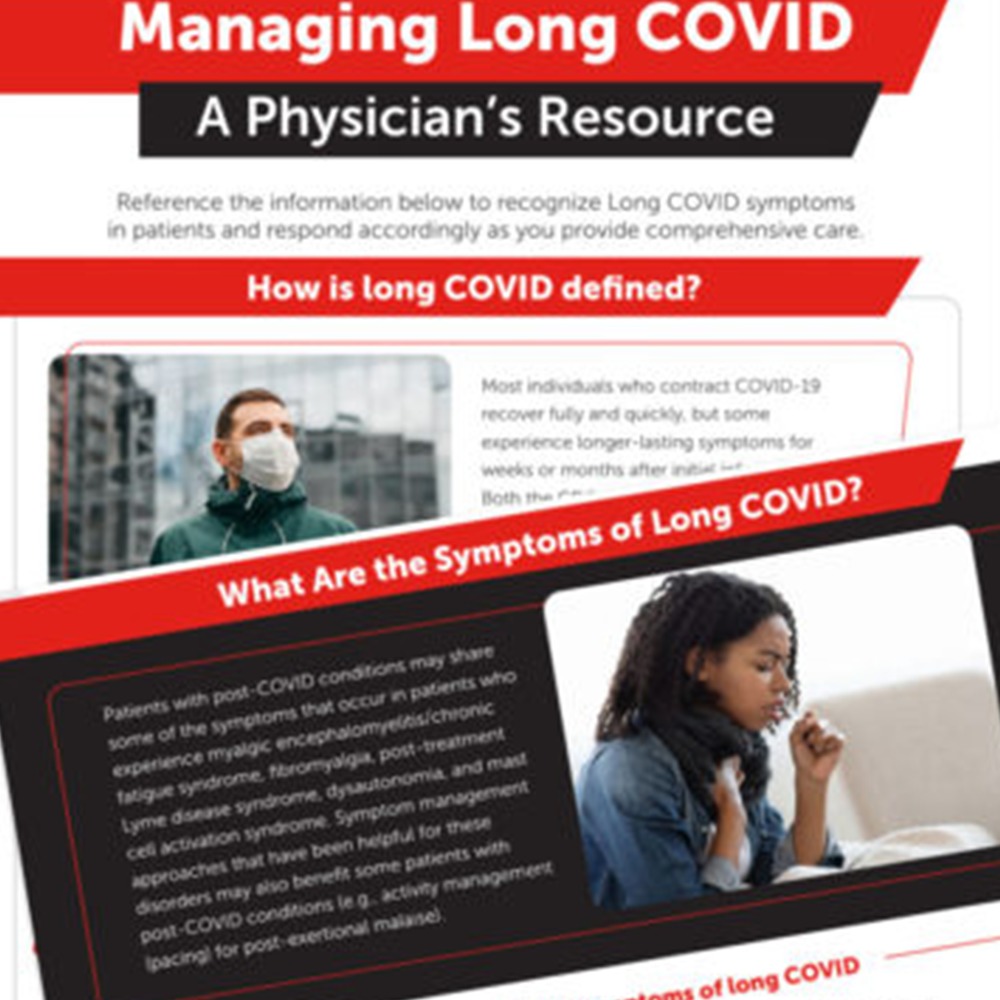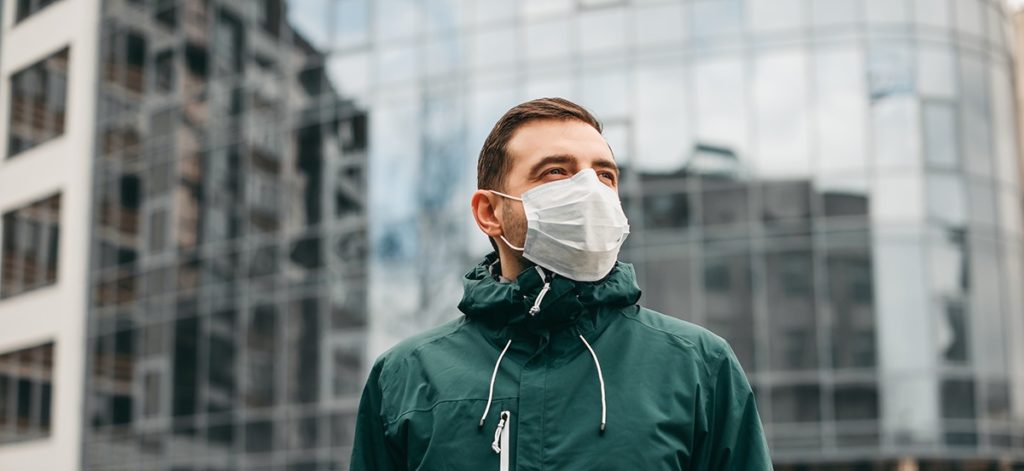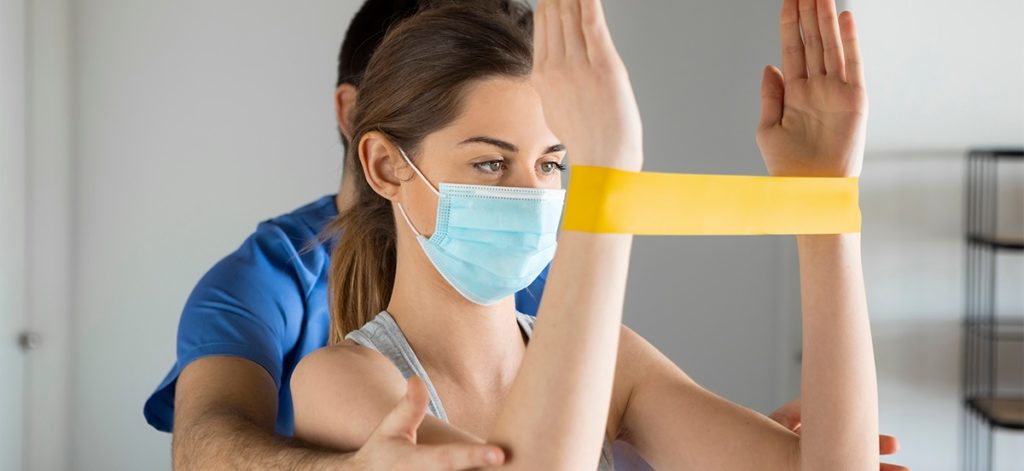Over the last two years, health care professionals and researchers have continued to learn more about the long-term effects of COVID-19. They have seen that a quick and full recovery is not a guarantee, even in those with mild to moderate initial infections and those who did not experience organ damage from their initial infection.
Up to 30% of patients with COVID-19 experience long-term chronic symptoms affecting their physical, cognitive, and emotional health. The Real-Time Assessment of Community Transmission-2 (REACT-2) study of more than 500,000 UK citizens showed one-third experiencing at least one COVID symptom over 12 weeks or longer. Nearly 15% reported three or more symptoms lasting 12 weeks or longer.
In October 2021, long COVID experts from leading institutions such as Yale School of Medicine, Einstein College of Medicine at Montefiore, and Mount Sinai Health, delivered a live webinar entitled Managing Long COVID: A Multidisciplinary Approach. Moderated by Mike Fox, PT, SCS, of MOTION PT Group, a leading provider of outpatient rehabilitation, the webinar covered a variety of topics, including symptom profiles, physician-patient communication strategies, and care team roles in patient recovery.
Erica S. Spatz, MD, Associate Professor of Cardiovascular Medicine and Epidemiology and the Director of Preventive Cardiovascular Health Program at Yale School of Medicine, is a post-COVID researcher and key member of the Post-COVID Recovery Program at Yale. Spatz notes, “Very quickly we realized that our appointment slots were being filled by people that had mild or moderate infection, were never in the emergency room or hospitalized, and yet were suffering from multi-organ debilitating symptoms.”
“One of the most important takeaways of long-COVID studies is that they reflect patients who were overwhelmingly not hospitalized, did not develop viral pneumonias, and do not present any markers of severe illness or organ injury,” remarked Marjan Islam, MD, Assistant Professor in the Division of Pulmonary Medicine and Co-Director of the CORE Clinic at Einstein College of Medicine and Montefiore Medical Center. “Approximately 10-30% of all patients who had acute COVID-19 ended up experiencing some of the hallmark symptoms of long COVID during extended time frames.”[/vc_column_text][vc_separator][/vc_column][/vc_row][vc_row content_placement=”middle”][vc_column width=”1/2″][vc_column_text]
Managing Long COVID: Downloadable Resources
Check out our on-demand webinar and infographic from experts leading the charge in treatment for Post-Acute COVID Syndrome (PACS).
Defining Long COVID
The National Institute of Health (NIH) proposes an umbrella term for all disease manifestation after the initial SARS-CoV-2 infection called PASC, or post-acute sequelae of SARS-CoV-2 infection. Members of the medical community commonly refer to the condition as “long COVID” and patients refer to themselves as “long-haulers.”
The U.S. Centers for Disease Control & Prevention (CDC) defines several types of post-COVID conditions characterized by a broad range of both mental and physical symptoms. The World Health Organization (WHO) released its first official definition of long COVID as a condition “occurring in individuals with a history of probable or confirmed SARS-CoV-2 infection, usually 3 months from the onset of COVID-19 with symptoms that last for at least 2 months and cannot be explained by an alternative diagnosis.”
Long COVID Patient Profile
Research supports that the patient profile for long COVID may vary. The Mayo Clinic released a study characterizing those afflicted with long COVID as:
- Young (average age of 45)
- Primarily female (68%)
- Not hospitalized during their initial COVID onset (75%)
About 90 days after their initial diagnosis, these patients still showed symptoms, which included:
- Fatigue
- Labored breathing (or dyspnea)
- Neurologic conditions ranging from cognitive impairment to dizziness
One possible explanation for the fatigue is a “state of chronic low-grade neuroinflammation generated by the disease.”
A larger, international study looked at more than 3,700 patients from 56 countries and found, again, that patients were primarily female, young, and not initially hospitalized but now exhibited long-COVID symptoms that included tiredness and brain fog.
Mount Sinai Health System published a JAMA study of 740 patients with an average age of 49 that were experiencing post-COVID brain fog as well. They documented a noticeable decline in cognitive ability nearly three months after their initial COVID diagnosis, affecting:
- Category fluency
- Executive functioning
- Memory encoding
- Memory recall
- Phonemic fluency
- Processing speed
Jenna Tosto Mancuso, P.T., D.P.T., N.C.S., is the Clinical Director of the Abilities Research Center at Mount Sinai Health. Dr. Mancuso remarks, “As we are still looking to understand the pathophysiological mechanism underlying long COVID, we as a medical community have started to identify the role of the autonomic nervous system in symptom presentation.” This includes the fatigue, headache, and brain fog common in long-COVID sufferers.
Many patients also experience post exertional malaise (PEM), characterized by “a crash after exercising or the crash after having a busy day running errands,” notes Dr. Spatz of Yale. These symptoms can include fatigue, brain fog, dizziness, joint pain, chest tightness, and even difficulty sleeping—all symptoms that also resemble chronic fatigue syndrome.
Physician-Patient Communication and Approach to Care
Seth Congdon, MD, Assistant Professor in the Division of Internal Medicine and Co-Director of the CORE Clinic at Albert Einstein College of Medicine and Montefiore Medical Center, notes that many patients are presenting with systemic symptoms such as cough, headache, and loss or distortion of smell (also known as anosmia or parosmia). “We’re seeing patients whose sense of smell hasn’t returned to normal in over a year. Unfortunately, there have not been much data on specific treatments to speed this process of recovery,” says Dr. Congdon. He recommends a process of olfactory training to slowly retrain the sense of smell.
During initial patient evaluation, Dr. Congdon recommends first validating the patient’s experiences by naming the condition and acknowledging that our understanding of long COVID is still developing. Pledging to work closely with the patient to overcome troublesome symptoms is the first step toward establishing management of these complex cases. Dr. Congdon also recommends:
- Conduct a patient-centered interview. If the symptom burden is overwhelming, ask the patient to choose two or three to focus on in the beginning.
- Arrange for close follow up of short- and long-term goals. As some symptoms see improvement, plan to address those remaining.
- Screen for contributing mental as well as physical factors, such as anxiety or depression.
Dr. Congdon’s multidisciplinary approach to managing long COVID symptoms includes:
- For fatigue, assess and make a plan to improve sleep with cognitive behavioral therapy, melatonin, and consider screening for sleep apnea
- For exercise intolerance, conduct an in-office walk test with Sp02 monitoring, along with PFTs, CBC, and a chest CT, and potentially refer the patient for physical therapy and/or pulmonary rehabilitation
- For orthostatic intolerance, conduct a 10-minute lean test and counsel the patient to use compression stockings and stay hydrated, as well as refer them to a cardiologist
- For brain fog, refer the patient to neuropsychology or cognitive rehab
Long COVID can also affect quality of life. Dr. Congdon recommends engaging community health resources to address social determinants of health, such as food or housing insecurity.
How Can Physical Therapy Impact Long COVID?
Physical therapy plays a critical role in the successful recovery from long COVID. Physical therapists assess physical and functional impairments and monitor, measure, and collect patient progress data. As movement experts, they are uniquely qualified to help patients recover their physical function quickly, safely, and effectively.
Physical Rehabilitation for Non-Hospitalized Patients
Dr. Mancuso of Mount Sinai Health notes that long-COVID symptoms may exacerbate with physical exertion, stress, and dehydration. “As we think about rehabilitation protocols for these individuals, it’s important to take note not only of the symptoms but also what their triggers are.”
Dr. Mancuso points out that traditional aerobic exercise can also exacerbate long-COVID symptoms. Thus, a phased, individualized approach to rehabilitation is critical. Dr. Mancuso’s team at Mount Sinai developed a long COVID rehabilitation protocol called Autonomic Condition Therapy, which includes:
- An initial evaluation and cardiac testing/clearance
- Four weeks of pre-habilitation centering on autonomic breathing regulation
- More than 12 weeks of physical therapy including autonomic condition therapy that is submaximal and designed to avoid symptom triggers
Focusing on breath control as part of the initial physical therapy protocol also helps to stabilize some of these debilitating symptoms.
Physical Rehabilitation for Previously Hospitalized Patients
Puneet Dhaliwal, P.T., D.P.T., M.A., physical therapist at MOTION Sports Medicine and supervisor of the neurologic and pulmonary rehabilitation services at New York Presbyterian Brooklyn Methodist Hospital, notes from her clinical experience that approximately half of patients hospitalized for COVID-19 are diagnosed with post-intensive care syndrome (PICS) after discharge. PICS is defined as new or increasing impairment of physical and mental function after a critical illness. PICS sufferers can experience a range of symptoms such as:
- Cognitive–memory loss, thinking problems, difficulty talking, poor concentration, forgetfulness
- Emotional–PTSD, anxiety, depression, lack of motivation
- Physical–fatigue, decreased mobility, problems breathing, muscle weakness
Dr. Dhaliwal says, “Clinicians used to focus more on the immediate short-term outcomes of patients. More recently, medical professionals have shifted their attention to the long-term outcomes of critical illness survivors. What they discovered is that although ICU survival improved, some patients did not return to their former level of function for weeks, months, and even years.”
Screening for PICS should include pulmonary, neuromuscular, mental, and physical function. Customized treatment can include mental health support and physical therapy, including exercise interventions that are:
- Compensatory and task-specific
- Restorative to enhance strength, function, balance, and endurance
To learn more from these experts on multidisciplinary management of long COVID, visit https://motionptg.com/webinar-managing-long-covid/.








